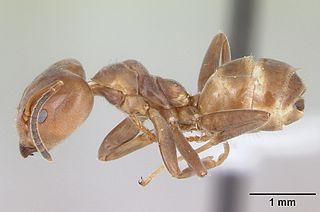
Auguste-Henri Forel was a Swiss myrmecologist, neuroanatomist, psychiatrist and eugenicist, notable for his investigations into the structure of the human brain and that of ants. He is considered a co-founder of the neuron theory. Forel is also known for his early contributions to sexology and psychology. From 1978 until 2000 Forel's image appeared on the 1000 Swiss franc banknote.

Dolichoderinae is a subfamily of ants, which includes species such as the Argentine ant, the erratic ant, the odorous house ant, and the cone ant. The subfamily presents a great diversity of species throughout the world, distributed in different biogeographic realms, from the Palearctic, Nearctic, Afrotropical region and Malaysia, to the Middle East, Australian, and Neotropical regions.

Azteca is a strictly Neotropical genus of ants in the subfamily Dolichoderinae. The genus is very diverse and contains around 84 extant species and two fossil species. They are essentially arboreal and many species have mutualistic associations with particular plant species, where the genus Cecropia presents the most conspicuous association. In the Brazilian Amazonia, Azteca species are associated with species of Codonanthopsis.
Dolichoderus butteli is a species of ant in the genus Dolichoderus. Described by Auguste-Henri Forel in 1913, the species is endemic to Indonesia.

Dolichoderus indrapurensis is a species of ant in the genus Dolichoderus. Described by Auguste-Henri Forel in 1912, the species is endemic to Borneo and Indonesia.
Dolichoderus jacobsoni is a species of ant in the genus Dolichoderus. Described by Auguste-Henri Forel in 1909, the species is endemic to Indonesia.
Dorymyrmex richteri is a species of ant in the genus Dorymyrmex. Described by Forel in 1911, the species is endemic to Argentina.
Dorymyrmex wolffhuegeli is a species of ant in the genus Dorymyrmex. Described by Forel in 1911, the species is endemic to Argentina.

Azteca adrepens is a species of ant in the genus Azteca. Described by Auguste-Henri Forel in 1911, the species is endemic to Paraguay.
Azteca aesopus is a species of ant in the genus Azteca. Described by Auguste-Henri Forel in 1908, the species is endemic to Brazil.

Azteca alfari is a species of ant in the genus Azteca. Described by Carlo Emery in 1893, the species is widespread in Mexico, Central and South America. This ant has a mutualistic relationship with a Cecropia tree. The specific name alfari honours a Costa Rican zoologist Anastasio Alfaro.
Azteca barbifex is a species of ant in the genus Azteca. Described by Auguste-Henri Forel in 1906, the species is endemic to North America and South America.
Azteca brevis is a species of ant in the genus Azteca. Described by Auguste-Henri Forel in 1899, the species is endemic to Costa Rica and Nicaragua.

Azteca chartifex is a species of ant in the genus Azteca. Described by Forel in 1896, the species is endemic to various countries in North America and South America.
Azteca christopherseni is a species of ant in the genus Azteca. Described by Forel in 1912, the species is endemic to Panama.

Azteca coeruleipennis is a species of ant in the genus Azteca. Described by Emery in 1893, the species is endemic to several countries in North America and Central America.
Azteca cordincola is a species of ant in the genus Azteca. Described by Forel in 1921, the species is endemic to Bolivia.
Azteca crassicornis is a species of ant in the genus Azteca. Described by Emery in 1893, the species is endemic to Brazil.
Azteca depilis is a species of ant in the genus Azteca. Described by Carlo Emery in 1893, the species is endemic to South America.

Azteca muelleri is a species of ant in the genus Azteca. Described by the Italian entomologist Carlo Emery in 1893, the species is native to Central and South America. It lives in colonies in the hollow trunk and branches of Cecropia trees. The specific name muelleri was given in honour of a German biologist Fritz Müller, who discovered that the small bodies at the petiole-bases of Cecropia are food bodies.







